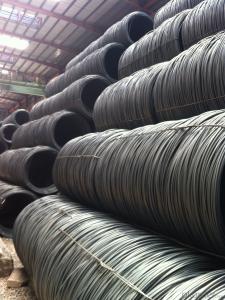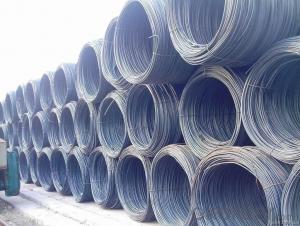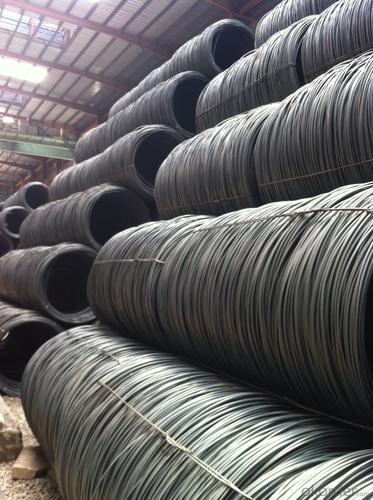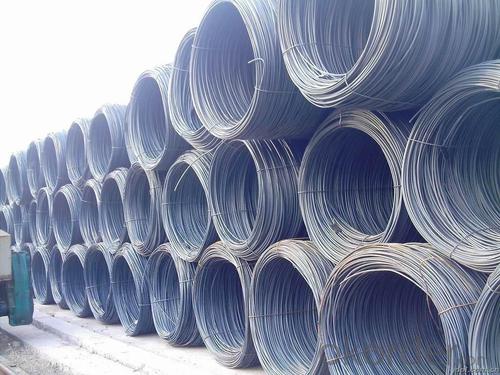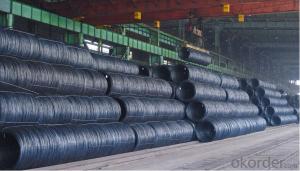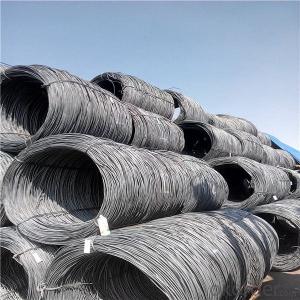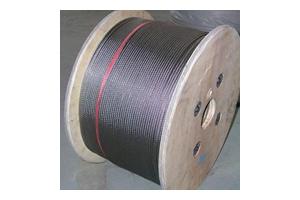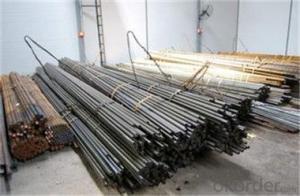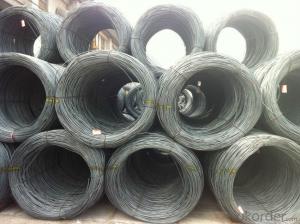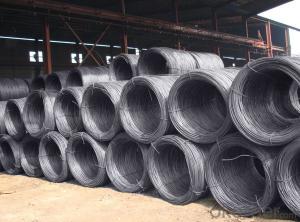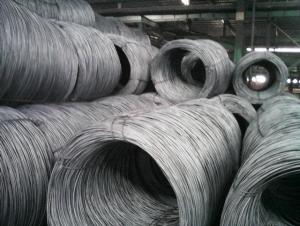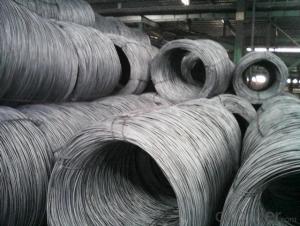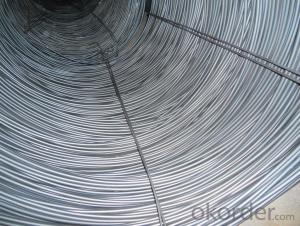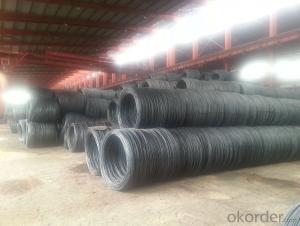Hot Rolled Low Canbon Wire Rods with Good Price
- Loading Port:
- Tianjin
- Payment Terms:
- TT OR LC
- Min Order Qty:
- 25 m.t
- Supply Capability:
- 10000 m.t/month
OKorder Service Pledge
OKorder Financial Service
You Might Also Like
OKorder is offering wire rods at great prices with worldwide shipping. Our supplier is a world-class manufacturer of steel, with our products utilized the world over. OKorder annually supplies products to European, North American and Asian markets. We provide quotations within 24 hours of receiving an inquiry and guarantee competitive prices.
Product Applications:
After hot-rolled the products shaped into coil and delivery as finished product, including round, square,rectangular, hexagonal and so on. Since most of the products are round, it is generally called wire rod. Carbon steel wire rod is widely used in construction and manufacturing. Carbon steel wire rod is mainly used for reinforcement of reinforced concrete and welded structure or reprocessed (roberts , nail, etc.) materials, especially used to produce wire drawing, welding electrode, nails, spring, electronic, precise machinery parts and so on.
Product Advantages:
OKorder's Wire rods are durable, strong, and resist corrosion.
Main Product Features:
· Premium quality
· Prompt delivery & seaworthy packing (30 days after receiving deposit)
· Corrosion resistance
· Can be recycled and reused
· Mill test certification
· Professional Service
· Competitive pricing
Product Specifications:
Manufacture: Hot rolled
Grade: SAE1006-SAE1018
Certificates: ISO, SGS, BV, CIQ
Packaging: Export packing, nude packing, in coils
Grade | Chemical Composition (%) | |||||
C | Mn | S | P | Si | B | |
SAE1008B | 0.10max | 0.32max | 0.045max | 0.040max | 0.30max | 0.0008min |
Mechanical properties | ||||||
Yield strength(N/mm2) | Tensile strength(N/mm2) | Elongation (%) | ||||
≥195 | 350-380 | ≥32 | ||||
FAQ:
Q1: Why buy Materials & Equipment from OKorder.com?
A1: All products offered byOKorder.com are carefully selected from China's most reliable manufacturing enterprises. Through its ISO certifications, OKorder.com adheres to the highest standards and a commitment to supply chain safety and customer satisfaction.
Q2: How do we guarantee the quality of our products?
A2: We have established an advanced quality management system which conducts strict quality tests at every step, from raw materials to the final product. At the same time, we provide extensive follow-up service assurances as required.
Q3: How soon can we receive the product after purchase?
A3: Within three days of placing an order, we will begin production. The specific shipping date is dependent upon international and government factors, but is typically 7 to 10 workdays.
Q4: Can stainless steel rust?
A4: Stainless does not "rust" as you think of regular steel rusting with a red oxide on the surface that flakes off. If you see red rust it is probably due to some iron particles that have contaminated the surface of the stainless steel and it is these iron particles that are rusting. Look at the source of the rusting and see if you can remove it from the surface.
Images:
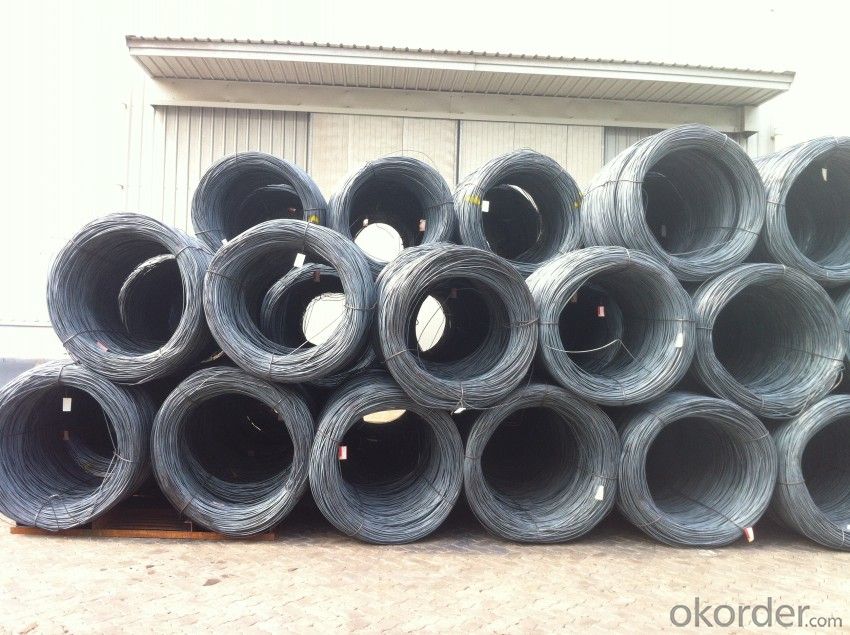
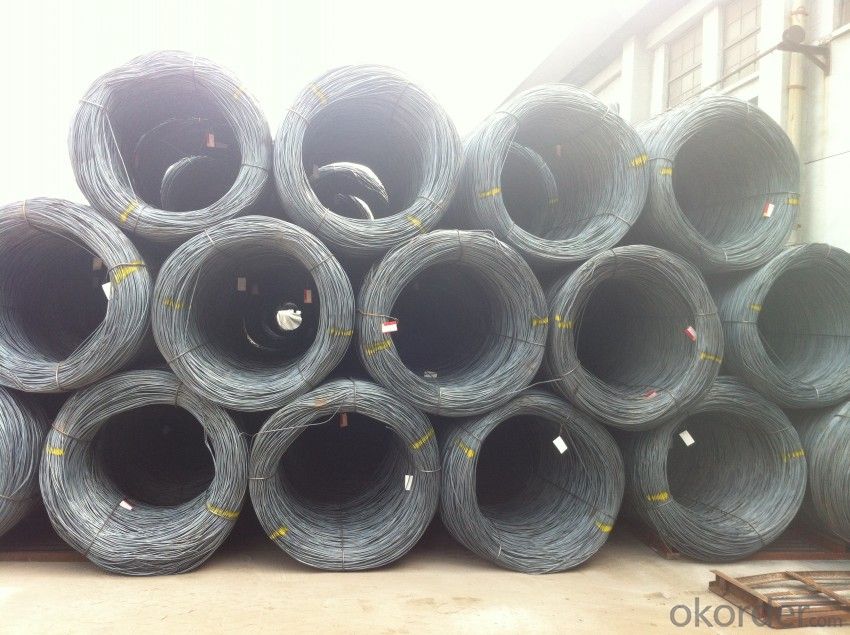
- Q: How is steel wire rod used in the manufacturing of wire forms for conveyor belts?
- To manufacture wire forms for conveyor belts, a crucial component is steel wire rod. Typically made of carbon or stainless steel, this high-quality wire rod is heated and passed through rollers to reduce its diameter to the desired size for the wire forms. Once properly sized, the wire rod is then shaped into various wire forms used in conveyor belts. Depending on the specific design requirements, these wire forms can be spiral wires, straight wires, or preformed wires. Crafted with care, these wire forms provide durability, strength, and flexibility. This is essential as conveyor belts endure continuous and heavy-duty use, carrying different materials and products. The wire forms provide the necessary support and structure for the belt to function effectively. In addition to structural support, wire forms also play a crucial role in tracking and guiding the conveyor belt. Strategically positioned, they help maintain the belt's alignment and prevent it from deviating from its intended path. This promotes smooth and reliable operation, reducing downtime and maximizing productivity. Moreover, steel wire rod chosen for wire forms in conveyor belts is known for its corrosion resistance and high tensile strength. This ensures the wire forms can withstand harsh environmental conditions, such as moisture, chemicals, and extreme temperatures, without compromising their integrity. Overall, steel wire rod is an essential component in manufacturing wire forms for conveyor belts. It provides the necessary strength, durability, and flexibility for efficient conveyor systems. By selecting high-quality steel wire rod and employing precise manufacturing techniques, conveyor belt manufacturers can produce wire forms that meet the specific needs of their customers, resulting in reliable and long-lasting conveyor belt systems.
- Q: How is steel wire rod used in the oil and gas industry?
- Steel wire rod is used in the oil and gas industry for various applications such as reinforcing concrete structures, manufacturing drilling equipment, and constructing oil rigs. It is commonly used as a strong and durable material that can withstand high pressures and temperatures in the extraction and transportation of oil and gas.
- Q: How are steel wire rods used in the manufacturing of wire mesh for reinforcement?
- Due to their exceptional strength and durability, steel wire rods find widespread use in the production of wire mesh for reinforcement. These rods serve as the primary raw material for creating wire mesh. To begin the process, the steel wire rods are heated to high temperatures in order to soften them, facilitating easier shaping and manipulation into the desired wire mesh configuration. Subsequently, the softened rods are passed through a series of dies, gradually reducing their diameter and increasing their length. This drawing process enhances the mechanical properties of the wire rods, including tensile strength and ductility. Once the wire rods have been drawn to the desired size, they undergo further processing using specialized machines to produce the wire mesh. These machines weave or weld the individual wires together, forming a grid-like pattern commonly used for reinforcement purposes. The wire mesh is meticulously designed to provide structural support and enhance the strength of various construction materials, such as concrete. Wire mesh reinforcement is extensively employed in construction projects to prevent cracking, improve load-bearing capacity, and enhance overall structural durability. It is commonly utilized in concrete slabs, walls, columns, and foundations. The steel wire rods utilized in wire mesh manufacturing offer the necessary strength and structural integrity to withstand heavy loads and resist tension forces. In conclusion, steel wire rods play a critical role in the manufacturing of wire mesh for reinforcement. Their high strength, durability, and malleability make them an ideal material for creating wire mesh products. Through a series of processes, the wire rods are transformed into wire mesh that provides structural support and enhances the strength of various construction materials.
- Q: What are the different hardness testing methods for steel wire rod?
- There are several different hardness testing methods that can be used to evaluate the hardness of steel wire rods. These methods include: 1. Rockwell Hardness Test: This is one of the most commonly used methods for hardness testing. It involves indenting the surface of the steel wire rod using a diamond cone or steel ball. The depth of the indentation is measured and correlated to a hardness value. 2. Brinell Hardness Test: This method also involves indenting the surface of the steel wire rod, but with a larger ball compared to the Rockwell test. The diameter of the indentation is measured and converted to a hardness value. 3. Vickers Hardness Test: This method uses a square-based diamond pyramid indenter to create an indentation on the surface of the steel wire rod. The size of the indentation is measured and the hardness value is calculated based on the applied load and the surface area of the indentation. 4. Knoop Hardness Test: This method is similar to the Vickers test, but it uses a rhombic-based diamond indenter instead. The length of the indentation is measured and the hardness value is calculated based on the applied load and the projected area of the indentation. 5. Microhardness Testing: This method involves using a microhardness tester to measure the hardness of the steel wire rod at a microscopic level. It is particularly useful for evaluating the hardness of different regions within the wire rod or for evaluating smaller samples. These different hardness testing methods provide valuable information about the mechanical properties of steel wire rods, allowing manufacturers to ensure that the rods meet the required hardness specifications for their intended applications.
- Q: How is the surface finish of steel wire rod determined?
- The surface finish of steel wire rod is determined through a combination of manufacturing processes and quality control measures. First, the steel wire rod is produced through a hot rolling process, where the steel is heated and passed through a series of rollers to achieve the desired shape and thickness. During this rolling process, the surface of the steel wire rod can develop imperfections such as scale, which is a layer of oxide that forms on the surface due to the high temperatures involved. To remove this scale and improve the surface finish, the steel wire rod may undergo a descaling process, which involves methods like acid pickling or mechanical descaling. After descaling, the steel wire rod may undergo further processes like cold drawing or heat treatment to achieve the desired mechanical properties. These additional processes can also contribute to improving the surface finish of the steel wire rod. To ensure the desired surface finish is achieved, quality control measures are implemented throughout the manufacturing process. This includes regular inspections and testing of the steel wire rod to detect any surface defects or imperfections. Various techniques such as visual inspection, ultrasonic testing, and surface profilometry can be used to evaluate the surface finish and ensure it meets the required standards. In conclusion, the surface finish of steel wire rod is determined through a combination of manufacturing processes such as rolling, descaling, cold drawing, and heat treatment. Quality control measures are also implemented to inspect and test the surface finish, ensuring it meets the desired standards.
- Q: How is steel wire rod used in the production of fencing and mesh?
- Steel wire rod plays a crucial role in producing fencing and mesh due to its strength, durability, and versatility. These qualities make it an excellent material for creating fences and mesh that can withstand different environmental conditions and provide a high level of security. To manufacture steel wire rod, it goes through hot rolling or cold drawing in the production process. Afterward, the wire rod undergoes further processing to transform it into various forms such as wires, bars, and strands. These forms are then used to create the different components needed for fencing and mesh. When it comes to fencing, steel wire rod is commonly used to create the main structural components like posts and rails. Typically, the wire rod is bent and welded to achieve the desired shape and size. These components are then interconnected and reinforced with additional wires, also made from steel wire rod, to create a sturdy fence structure. Steel wire rod is also utilized in making the mesh or netting of the fence. The wire rod is drawn into thin and flexible wires, which are tightly woven or welded together to form a mesh pattern. This mesh is then attached to the fence posts and rails, providing a secure barrier while allowing visibility and ventilation. Moreover, steel wire rod is employed to create different types of fencing and mesh, including chain-link fences, welded wire mesh, and expanded metal mesh. Each type has its own unique characteristics and applications, but they all rely on the strength and durability of steel wire rod to offer security and protection. In conclusion, incorporating steel wire rod in the production of fencing and mesh ensures that these structures are robust, long-lasting, and capable of enduring harsh conditions. The versatility of steel wire rod allows for the creation of various fence and mesh designs, making it an indispensable material in the construction industry.
- Q: How is steel wire rod used in the manufacturing of wire forms for filtration systems?
- Steel wire rod is an essential component in the manufacturing of wire forms for filtration systems. The wire rod serves as the primary raw material for producing wires of various diameters and strengths, which are then shaped into specific forms used in filtration systems. To begin the manufacturing process, the steel wire rod is first carefully selected based on its composition, mechanical properties, and desired characteristics. This ensures that the wire rod is suitable for the specific filtration system requirements, such as resistance to corrosion, high tensile strength, and durability. Once the appropriate steel wire rod is chosen, it undergoes a series of manufacturing steps to transform it into wire forms for filtration systems. The wire rod is first cleaned and descaled to remove any impurities or surface contaminants that may affect its performance. It is then heated to a specific temperature to make it more malleable and easier to shape. The heated wire rod is then passed through a series of dies or molds, which give it the desired shape and dimensions for the wire forms used in filtration systems. The wire may be drawn through multiple dies to achieve the desired diameter and strength required for effective filtration. After shaping, the wire forms go through additional processes like annealing, which involves heating and slowly cooling the wire to relieve any stresses and improve its ductility. This step ensures that the wire forms can withstand the demands of filtration systems, such as high pressure or constant use. Once the wire forms are manufactured, they can be further processed or assembled into complete filtration systems. For example, the wire forms may be welded or joined together to create mesh screens or filter elements, which are then integrated into the overall filtration system design. Overall, steel wire rod plays a crucial role in the manufacturing of wire forms for filtration systems. Its versatility, strength, and ability to be shaped and transformed into various forms make it an ideal material for producing wires that meet the specific requirements of filtration systems. Whether it's for removing contaminants from liquids or gases, steel wire rod ensures the durability and effectiveness of filtration systems in a wide range of industries.
- Q: What are the different types of steel wire rod coatings available?
- Steel wire rods can be coated with various types of coatings, each offering unique advantages. Some common coatings include: 1. Galvanized Coating: Zinc is applied to the surface of the steel wire rod, providing excellent corrosion resistance. This makes it suitable for outdoor applications or environments with high humidity or exposure to corrosive substances. 2. Phosphating Coating: A chemical conversion process creates a thin layer of phosphate crystals on the surface of the steel wire rod. This coating improves adhesion, corrosion resistance, and acts as a good base for painting or further treatment. 3. Polymer Coating: Polyethylene or polypropylene coatings protect against corrosion, abrasion, and chemical exposure. These coatings are highly flexible and can be customized to meet specific requirements like UV resistance or electrical insulation. 4. Epoxy Coating: Known for exceptional adhesion and chemical resistance, epoxy coatings are commonly used in environments with harsh chemicals, like the oil and gas industry or marine environments. They also protect against corrosion and abrasion. 5. Zinc-Aluminum Coating: This coating involves applying a layer of zinc-aluminum alloy to the steel wire rod. It offers excellent corrosion resistance and is often used in applications requiring both corrosion and heat resistance, such as automotive or construction industries. 6. Copper Coating: Copper coatings are primarily used for their electrical conductivity properties. They enhance conductivity and reduce electrical resistance in steel wire rods used for electrical applications like wiring or cables. These examples highlight the various coatings available for steel wire rods. The selection depends on specific requirements like corrosion resistance, electrical conductivity, or chemical resistance. Choosing the appropriate coating ensures optimal performance and durability of the steel wire rods.
- Q: What are the typical mechanical properties of steel wire rod?
- The typical mechanical properties of steel wire rod include high tensile strength, good ductility, and excellent resistance to bending and stretching. It also exhibits low elasticity, making it suitable for applications that require high strength and durability.
- Q: What are the standard hardness requirements for steel wire rod?
- The standard hardness requirements for steel wire rod can vary depending on the specific application and industry standards. However, in general, steel wire rod is commonly required to have a hardness of around 100-300 HB (Brinell hardness) or 10-30 HRC (Rockwell hardness). These hardness requirements ensure the wire rod's strength and durability for various purposes, such as manufacturing springs, cables, and reinforcing materials.
Send your message to us
Hot Rolled Low Canbon Wire Rods with Good Price
- Loading Port:
- Tianjin
- Payment Terms:
- TT OR LC
- Min Order Qty:
- 25 m.t
- Supply Capability:
- 10000 m.t/month
OKorder Service Pledge
OKorder Financial Service
Similar products
Hot products
Hot Searches
Related keywords
